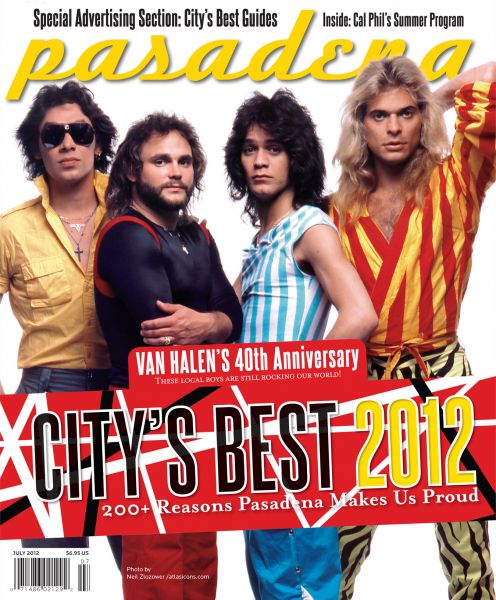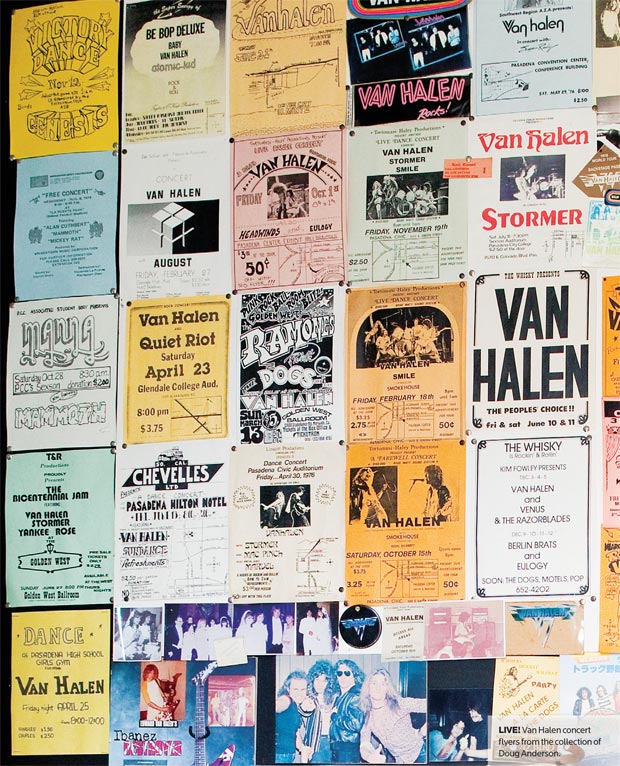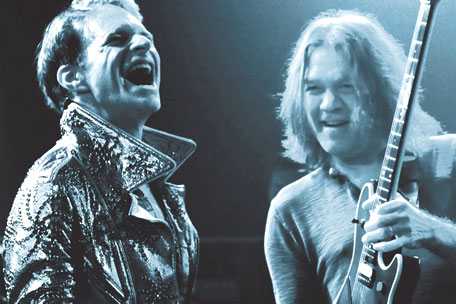
Special thanks to Pasadena Magazine for sharing their article with VHND readers!
Pasadena, CA, July 2, 2012 — Pasadena Magazine is proud to celebrate the 40th anniversary of hard rocking local boys Van Halen with a cover story by writer, musician and air guitar champion Dan Crane (star of Air Guitar Nation), pegged to the release of their latest album, A Different Kind of Truth, and recent concert tour.
Legendary rock photographer Neil Zlozower shot the iconic 1981 cover image, as well as a classic portrait of the band posing on the steps of David Lee Roth’s Pasadena mansion in 1979, featured inside. Zlozower is also part of the piece, reminiscing about the bond he and the band shared: “We all had a lot of stuff in common like girls, and drinking, and having a good time. And the next thing you know we were all best friends and hanging together.”
A collection of early concert flyers from Doug Anderson’s collection in Altadena is also featured. Plus, high school pals of the band remember the glory days of demo recordings and backyard keg parties.
Shredding Sons
40 years after Van Halen first rocked the gymnasium at Pasadena High, these local boys are back in the spotlight. Some old pals remember the early days.
Written by Dan Crane / Photos by Neil Zlozower
From the opening riff of “Unchained” from 1981’s Fair Warning, the capacity crowd at L.A.’s Staples Center on June 1st was at its feet, screaming along with every lyric they could decipher or remember. supporting A Different Kind of Truth, (Interscope Records), their first studio effort with David Lee Roth on vocal duty since the album 1984, Van Halen proved they can still lay claim to being one of the greatest rock ‘n’ roll acts around.
Although Roth’s vocals didn’t quite reach his glory day perfection, his mic-stand martial arts moves, high kicks and maniacal smile made up for what his pipes couldn’t deliver. Eddie Van Halen—backed by brother Alex and 21-year-old son Wolfgang on bass—was as awe-inspiring as ever, delivering a roughly ten-minute long extended version of his solo six-string masterpiece, “Eruption.”
Foregoing the trappings of the modern stadium rock concert (crazy light shows, fog machines, giant inflatable animals) Van Halen instead offered a stripped-down, bare-bones, old-school rock ‘n’ roll approach. It was as if, after 40 years of animosity, alcoholism, and a rotating cast of lead singers, the band birthed in Pasadena in the early seventies was right back where they started, only, on a just slightly larger stage.
As children, brothers Alex and Eddie Van Halen moved with their parents from Holland to Pasadena in 1967. Their jazz musician father wasted no time getting the boys signed up for classical piano lessons, but it was clear early on that their musical passions lay elsewhere. Alex started playing guitar and Eddie tried drumming, but once Eddie heard Alex’s drum playing, he decided he should probably switch to guitar—the instrument for which he’d become known as the second coming of Jimi Hendrix.

The brothers Van Halen attended Pasadena High where they formed a power-trio called Mammoth, featuring Eddie on vocals and Michael Anthony, who fronted another band called Snake, on bass. [VHND notes: Van Halen’s origin traces back to 1972 when the band was called “Genesis” and was made up of Ed, Al and original bassist, Mark Stone. Soon after, Roth was hired as singer. Then in 1974, Stone was replaced by Michael Anthony]. In 1972 the brothers met David Lee Roth, lead singer for a band known as the Red Ball Jets. When they learned about another local group called Mammoth, Roth convinced the brothers to call the band Van Halen.
In those early days, Van Halen would play legendary, raucous house parties in Pasadena and the surrounding suburbs. To promote the shows they’d drive to all the local high schools and shove flyers into lockers.
“Every weekend there were backyard parties and they’d put flyers all around Pasadena High School and PCC. It was word of mouth,” recalls Gary Nissley, who went to high school with Eddie and Alex and was friendly with the band in the early days. “They were wild, mainly backyard parties, tons of people, and they’d set up sometimes full lights, full stage, and all the kegs would end up in the pool.”
Tom Broderick, another high school friend who worked as a sound mixer for the band from 1976-78, says of those early parties, “It was always a mystery when the cops didn’t show up. They would usually let them play to 11 or 12— get a few hours in at least. I tried to go to all the shows, but they were playing all the time so you could see them almost every weekend. They played at Pasadena High School in the auditorium and the gym for a dance.”
One venue where Van Halen honed their chops was the then newly-opened Pasadena Civic Center exhibition hall—a giant, subterranean room where sometimes as many as eight bands would play in one night. At first they were playing covers primarily, but eventually they began to fold more originals into their show. “It was a big deal when they played the Civic and they only did one cover,” says Broderick. “Then they started playing Hollywood, and the rest is history…”
Nissley, who at the time was working at KPCC (then KPCS) and recorded many of their early gigs on reel-to-reel, even tried to shop the band around. “I was like, ‘You gotta listen to these guys!’ But everyone was looking for the next Jim Croce, they weren’t looking for a hard rock act. They were looking for Top 40, and Van Halen was a far cry from Carpenters records.”

The band soon started playing L.A. venues like Gazzari’s (now the Key Club) on Sunset Boulevard, and caught the attention of local music impresario and kingmaker Rodney Bingenheimer who got them a gig at the Starwood—a legendary West Hollywood club that is now a mini-mall. It was at the Starwood that they impressed Warner Bros. exec Mo Ostin, who quickly signed the band.
Their eponymous debut album, recorded in a mere three weeks, was released in February of 1978 and would go on to sell over 10 million copies, with many of the songs becoming perennial classic rock radio staples. The album’s best cuts—“Runnin’ With the Devil,” “Ain’t Talkin’ ‘bout Love” and a flawless cover of the Kinks’ “You Really Got Me”—infuse hard rock with a glossy, radio-friendly sheen. The band became known as poster boys for rock ‘n’ roll excess: groupies, alcohol, drugs, spandex, and colossal coifs of well-conditioned hair.
Legendary rock photographer Neil Zlozower recalls hearing “Runnin’ With the Devil” and “Eruption” in his office just after the debut album came out and thinking, “This is insane! Nobody’s ever played guitar like that. I gotta work with this band.” Zlowower went on to shoot hundreds of iconic Van Halen shots. “We all had a lot of stuff in common like girls, and drinking, and having a good time…and the next thing you know we were all best friends and hanging together.”
Musically, Van Halen put Pasadena on the map, says Zlozower. “What other major bands are from Pasadena? None that I can think of.”
Zlozower points out that most of the greatest hard rock bands prior to Van Halen—Led Zeppelin and The Who, to name two—had been British. “Van Halen took everything one step farther. They had an image as the American, fun-loving party rock band. Dave to me is one of the all-time greatest showmen…And Eddie’s guitar playing, there was nothing like it. Even when it came to designing the stage shows, the lighting, they were one up on everyone else. They took everything to the next level. On stage, backstage, at the hotel room – everything.”
In 1985, amidst clashes over drug use and creative control, David Lee Roth parted ways with Van Halen. The band went through a string of other lead singers over the years including Sammy Hagar and Gary Cherone, with Roth returning for a brief stint in the mid-nineties. Roth came back to the fold once more in 2006, and the band has been playing together—along with Eddie’s son Wolfgang on bass—ever since.

About a year ago, when Eddie was looking for material for the new Van Halen record, he tracked down some early recordings of the band to use as reference. Though they were reworked and went through a few lyrical changes, several tracks such as “Bullethead,” “She’s the Woman,” and the album’s first single, “Tattoo,” trace back to those early days in the ’70s when the band would rehearse in neighborhood basements and attics around Pasadena.
Live, the new songs blend in perfectly to the VH oeuvre. Sure, “Diamond Dave” has shed his blond mane, Eddie’s had a hip replacement and the bassist is just barely old enough to drink, but the boys from Pasadena can still inspire an entire stadium to grab an air guitar and party like it’s 1984.
Based in the heart of Pasadena, Pasadena Magazine is designed to showcase the people, places, charities and events that define the beauty and heritage that is Pasadena and the San Gabriel Valley. Featuring the finest of the region’s culture, dining, entertainment and business offerings, Pasadena Magazine caters to the interests of Southern California’s affluent, savvy readers.
Pasadena Magazine is available for purchase at all major news-stands, bookstores and grocers in the region and LA metro area. To subscribe go to www.pasadenarose.com